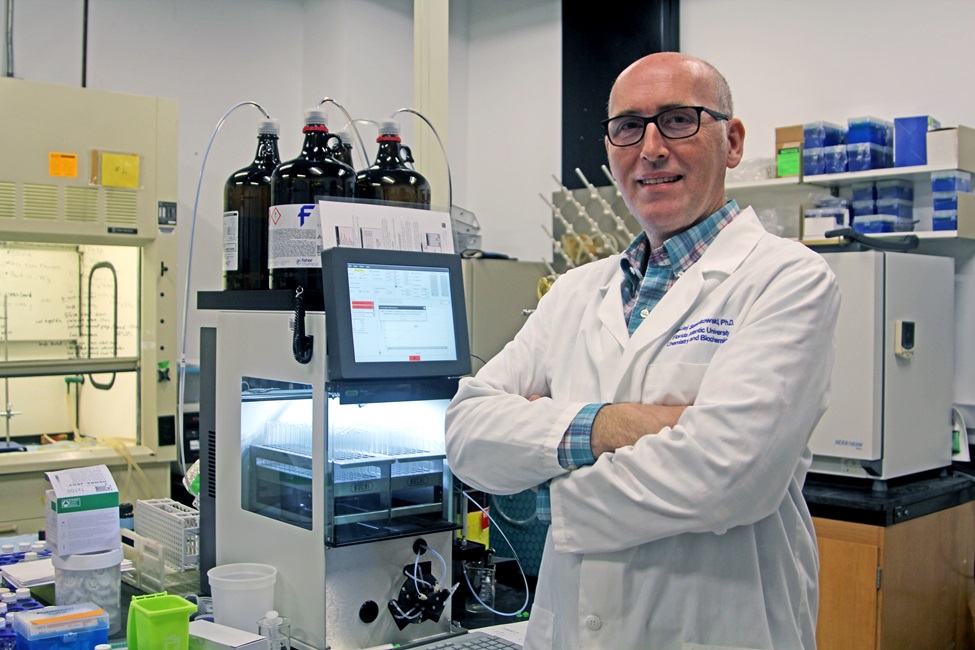Fluorescent Probes Illuminate Cholesterol and Alzheimer's Research

Maciej J. Stawikowski, Ph.D., senior author and an assistant professor of chemistry and biochemistry at FAU’s Charles E. Schmidt College of Science.
The search for answers to Alzheimer’s disease and other neurodegenerative disorders remains one of the most pressing goals in brain research. Maciej J. Stawikowski, Ph.D., an assistant professor of chemistry and biochemistry at Florida Atlantic University’s Charles E. Schmidt College of Science, believes the key may lie in understanding how cholesterol and other lipids move through cells and affect their communication.
“It’s well known that lipids and Alzheimer’s are linked,” said Stawikowski, a member of the FAU Stiles-Nicholson Brain Institute. “Lipid imbalance may lead to amyloid plaque formation – oversized protein clumps that disrupt cell function, a hallmark of Alzheimer’s.
His team, including Qi Zhang, Ph.D., an associate professor in the FAU Department of Chemistry and Biochemistry and a member of the FAU Stiles-Nicholson Brain Institute, has focused on developing advanced tools to investigate the relationship between lipids and cellular function.
Cholesterol is a crucial component of cellular membranes, enabling hormone production, membrane stability and signaling. However, disruptions in cholesterol movement between cell compartments may play a role in Alzheimer’s and other neurodegenerative diseases. To study this, Stawikowski and his team have developed novel fluorescent cholesterol probes (CNDs) designed to track cholesterol within cellular membranes.
A new study, published in Scientific Reports, demonstrates how CND probes can help at visualizing cholesterol in live cells. By combining computer simulations with live-cell imaging, the researchers have uncovered how different probe designs influence cholesterol probe behavior.
These innovative probes could enhance our understanding of how cholesterol imbalances contribute to Alzheimer’s disease and other neurodegenerative disorders. By understanding cholesterol’s role in amyloid plaque formation and cellular signaling, researchers could develop drugs to modulate lipid activity, potentially leading to new treatments or preventive strategies.
“With these probes, we can now visualize cholesterol movement and distribution in live cells with unprecedented detail,” said Stawikowski, senior author of the study.
The CND probes are designed using a 1,8-naphthalimide (ND) scaffold, which is renowned for its unique fluorescence properties, including large Stokes shifts and sensitivity to environmental changes. This novel design allows for modular customization, enabling researchers to tailor the probes with different head groups and linkers to meet specific experimental requirements. Findings show that modifying head groups or linkers could enhance the probes’ sensitivity and targeting ability.
These probes are categorized into three distinct types. Neutral probes tend to aggregate easily, but their cellular uptake is limited. Charged probes, on the other hand, demonstrate improved solubility and better interaction with cellular membranes. Probes containing hydroxyl groups further enhance hydrogen bonding and lipid interactions, making them particularly effective for studying membrane behavior.
Additionally, some variants of the CND probes are pH-sensitive, allowing researchers to track cholesterol movement in organelles with varying acidity, such as lysosomes and lipid droplets. Compared to traditional cholesterol probes, these tools offer superior fluorescence properties and more accurate tracking of cholesterol dynamics, providing deeper insights into cellular processes.
“Cholesterol is essential for brain function, but its dysregulation could be a key factor in disease progression,” said Stawikowski. “Our new tools provide a window into how cholesterol impacts cellular processes and may help identify therapeutic targets for conditions like Alzheimer’s.”
The research team’s fluorescent cholesterol probes offer applications beyond Alzheimer’s, with potential uses in membrane biology, lipid dynamics and drug delivery. By combining experimental techniques with computer simulations, the FAU team has laid the foundation for developing better fluorescent cholesteryl probes that can be used to study a wide range of lipid-related disorders.
These probes are versatile tools that can be tailored for diverse research needs, marking a major step forward in understanding cholesterol’s role in cellular health and disease.
Study co-authors are Zhang; Vincente Rubio, Ph.D.; Nicholas McInchak; Genesis Fernandez; Dana Benavides; Diana Herrera; and Catherine Jimenez; all FAU graduates; and Haylee Mesa, a doctoral student, FAU Stiles-Nicholson Brain Institute; and Jonathan Meade, an FAU graduate and laboratory technician.

This image showcases a snapshot from a molecular dynamics simulation. The simulation depicts the interactions of one of the researchers’ fluorescent probes (magenta) within a model lipid bilayer. The bilayer is surrounded by water (cyan), and native cholesterol is shown in orange. Through these simulations, researchers can determine how the modular structure of their probes influences molecular and cellular behavior. They can then compare these findings to the behavior of native cholesterol.
-FAU-
Latest Research
- Hope for Brain Cancer: FAU Awarded Grants for Glioblastoma TreatmentFAU researchers are pioneering a new approach to treating glioblastoma - a highly aggressive brain cancer with one of the highest mortality rates - by targeting the gene MBLAC1 for the first time.
- Chef José Andrés' Longer Tables Fund Will Expand FAU Queen Conch LabThe grant awarded to FAU Harbor Branch supports the expansion of its queen conch aquaculture lab and is part of a global philanthropic effort to tackle urgent challenges through the power of food.
- FAU Gets $1M to Prevent Medication-related Harm, Falls in Older AdultsFAU Schmidt College of Medicine researchers will develop a targeted approach to eliminate the guesswork in medication management to reduce the risk of adverse drug events - particularly dangerous falls.
- Suicide Risk Elevated Among Young Adults with DisabilitiesSuicide is the third leading cause of death in young adults. For those with intellectual and developmental disabilities, the crisis is worse. New research urges prevention, screening and intervention reforms.
- In Stereo: Neurons Shift Gears Between Thoughts Using Brain RhythmsAn FAU study provides a new understanding of how the brain organizes thoughts for navigation, memory and behavior - offering insights into neurological conditions like epilepsy, Alzheimer's and schizophrenia.
- FAU's CA-AI Makes AI Smarter by Cleaning Up Bad Data Before It LearnsFAU engineering researchers from the CA-AI have developed a method to automatically detect and remove label noise from data before training begins, resulting in smarter, faster and more reliable AI.






